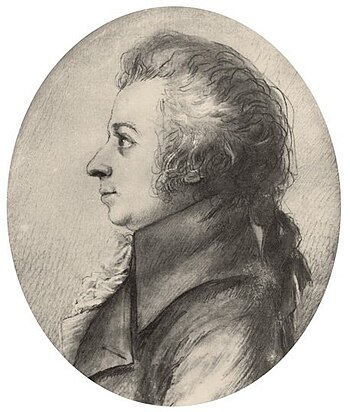 |
| Drawing of Mozart in silverpoint made by Dora Stock during Mozart's visit to Dresden, April 1789 (Photo credit: Wikipedia) |
Wolfgang Amadeus Mozart [1756 - 1791] began his amazing but tragically brief musical career as a child prodigy, making appearances as an accomplished violinist and keyboard player from the age of five. He was born in Salzburg in what is now the country of Austria, and lived most of his life in that land (then known as the Holy Roman Empire), although he travelled extensively throughout Europe -- in the company of his family as a child, and later on his own so as to supervise premieres of the various musical works he composed.
Despite Mozart's relatively short life -- the cause of his death at age 35 has been attributed to various ailments down through the years, although it was most likely a recurrence of rheumatic fever -- he was incredibly prolific as a composer. His material clearly exemplified what is known as the Classical style, the period of music that immediately followed the Baroque. In addition to 41 symphonies and close to a dozen masses and other large choral works (including his Requiem, which was left unfinished at his death), Mozart composed hundreds of chamber music pieces for various solo instruments and ensembles. Despite his success as a composer, however, he struggled financially throughout most of his life.
The era in which Mozart lived was a financially perilous one for writers of music. Without wealthy patrons to sponsor their works, most composers ended up working for the church in various roles. This might include organist, concertmaster, choir director, or some combination of the three. In his late teens, Mozart was assistant concertmaster for the archbishop of Salzburg but tired of the drudgery of composing only liturgical music while working with a group of equally low-paid musicians. Through the influence of his father, Leopold, a more prestigious post as Salzburg court organist was arranged; this helped raise his profile with the monarchy, which was where the real money resided.
Following Wolfgang's marriage to Constanze Weber in 1782 -- the couple relocated to Vienna soon after they were wed -- and thanks to the successes he enjoyed from having his music (especially operas) proliferate throughout Europe, five years later Emperor Joseph II named Mozart to succeed Christoph Willibald Gluck as the court's official chamber composer. Despite the relative financial stability, this position afforded him, Mozart's extravagant lifestyle outstripped his ability to pay for it. In a way, though, the world of music is the beneficiary of this indebtedness. Because of all the money he borrowed to pay for a fashionable Viennese apartment, private schooling for the two children (out of six) who survived infancy, the years 1787 through 1791 were his most prolific by far.
While his instrumental works remain the core of his legacy -- an expert once suggested that a Mozart composition is being performed somewhere in the world every second of every day -- it is his operas that seem to have enjoyed the greatest acclaim down through the years. Among his most famous pieces are works from his mature years, including Die Zauberflöte ("The Magic Flute"), The Marriage of Figaro, Don Giovanni, and Cosi fan tutte (roughly translated as "Women Are Like That"), the latter three collaborations with librettist Lorenzo da Ponte. But some of his earlier operas continue to enjoy support on the world's stages, notably Abduction from the Seraglio [1782]. His final opera was La Clemenza di Tito, which premiered only three months before he died.
The video clip that accompanies this article is the final scene from "The Marriage of Figaro." The performers include Bryn Terfel [Figaro], Alison Hagley [Susanna], Rodney Gilfrey [Count Almaviva], and Hillevi Martinpelto [Countess Almaviva]. The conductor is John Eliot Gardiner.
|

No comments:
Post a Comment